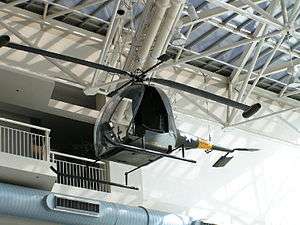Tip jet
A tip jet is a jet nozzle at the tip of some helicopter rotor blades, used to spin the rotor, much like a Catherine wheel firework. Tip jets replace the normal shaft drive and have the advantage of placing no torque on the airframe, so no tail rotor is required. Some simple monocopters are composed of nothing but a single blade with a tip rocket.[1][2]

Tip jets can use compressed air, provided by a separate engine, to create jet thrust. Other types use a system that functions similarly to the afterburner (reheat) on a conventional jet engine, except that instead of reheating a gas jet, they serve as the primary heater, creating greater thrust than the flow of pre-compressed air alone; the best description of this is thrust augmentation. Other designs includes ramjets or even a complete turbojet engine. Some, known as Rocket On Rotor systems, involve placing rockets on the tips of the rotor blades that are fueled from an onboard fuel tank.[3]
If the helicopter's engine fails, the tip jets on the rotor increase the moment of inertia, hence permitting it to store energy, which makes performing a successful autorotation landing somewhat easier. However, the tip jet also typically generates significant extra air drag, which demands a higher sink rate and means that a very sudden transition to the landing flare must occur for survival, with little room for error.
Origins
Austrian Ludwig Wittgenstein investigated the use of tip jets to drive an aircraft propeller while studying aeronautical engineering at Manchester University, UK and patented his ideas.[4] He soon left engineering and would become better known as a philosopher.
The Italian designer V Isacco built "Helicogyres" in the 1920s. Although they used piston engines at the ends of the rotary wing, he foresaw that they might be replaceable by jets.[5]
During the Second World War, German engineer Friedrich von Doblhoff suggested powering a helicopter with ramjets on the rotor tips. The first tip jet-powered helicopter was the WNF 342 V1 in 1943. After the war two WNF 342 prototypes ended up with the Americans and Doblhoff joined McDonnell Douglas who subsequently produced the McDonnell XV-1. The engineer who had actually produced the tip jet engines, August Stephan, joined the Fairey Aviation company of the United Kingdom which used them in their Fairey Jet Gyrodyne and Fairey Rotodyne aircraft first flying in 1954 and 1957 respectively.
Eugene Michael Gluhareff was an early pioneer of tip jets.
Rotorcraft using tip jets
Cold tip jets
The compressed air in cold tip jets generally exited at quite high temperatures due to compression-heating effects, but they are referred to as "cold" jets to differentiate them from jets that burn fuel to heat the air for greater thrust; similar to the difference between the "cold" and "hot" exhausts on the Harrier "Jump Jet", which uses "cold" air heated to several hundred degrees by compression inside the low-pressure compressor of the Pegasus engine.)
- Avimech Dragonfly DF-1 - American hydrogen peroxide powered helicopter
- Dornier Do 32 - German ultra-light tip-jet helicopter, first flown on 29 June 1962: 4 built.
- Dornier Do 132 - German tip-jet helicopter project, cancelled in 1969.
- Fiat 7002 - Italian tip-jet helicopter, first flew in 1961, only one built.
- Percival P.74 - used second compressors to blend turbine exhaust with more air for efflux at wingtips. Engines never produced sufficient power and so it never flew. Further progress with the design using more powerful engines was cancelled.
- Sud-Ouest Ariel - French tip-jet powered helicopter, first flown in 1947; three prototypes built.
- Sud-Ouest Djinn - French tip-jet powered helicopter, first flown in 1953; 178 built.
- VFW-Fokker H2 - German proof-of-concept autogyro adaptation of a Bensen B-8 autgyro with tip-jet–started rotor
- VFW-Fokker H3 - German tip-jet compound helicopter; two built and flown.[6]
Hot tip jets
- Doblhoff WNF 342 - German WWII helicopter with tip-jet rotor propulsion.
- Fairey Ultra-light Helicopter - First flew in 1955. Four built for military use but lack of interest led to Fairey concentrating on the larger Rotodyne project.
- Fairey Jet Gyrodyne - UK experimental tip-jet–powered rotor compound gyroplane, providing data for the Fairey Rotodyne. First flown in 1954.
- Fairey Rotodyne - UK compound gyrodyne with rotor driven by tip jets (compressed air and fuel burnt in tip combustion chambers) for VTOL. 48-seater short-haul airliner design. First flew in 1957. Cancelled due to lack of commercial interest; in part due to concern about noise of tip jets in service.
- Hughes XH-17 - US tip-jet-burner-powered flying crane (largest rotor of any type on a helicopter), cancelled due to inefficient design (range around 40 mi (64 km))
- McDonnell XV-1 - US experimental compound gyrodyne. competed with Bell XV-1 tilt-rotor. Flew in 1954, but cancelled due to insufficient advantage over contemporary helicopters.
Ramjets
- Hiller YH-32 Hornet - US ramjet helicopter, first flying 1950, 'jet jeep' had good lifting capability but was otherwise poor.
- Mil V-7 - Soviet ramjet helicopter
- Focke-Wulf Fw Triebflügel German World War II interceptor design, using ramjets - not built
- H-3 Kolibrie Dutch design of the 1950s by Nederlandse Helikopter Industrie; 11 built.
Pulsejets
Rockets
(Note: Fuel and oxidiser supplied to combustion chambers at the rotor tips.)
- Rotary Rocket Roton ATV - US re-usable rocket concept, originally designed with rocket-tip-jet–powered rotor.
See also
References
- Peklicz, Joseph, 2001, "Build the Monocopter" Sport Rocketry 44,2 March–April, 2001 p 34
- Hodge, Jon, 2000, "Monocopter C6 MII Review" Cosrocketeer, 12, 4, July–August, 2000 p. 4-5
- CLARK, JOHN D. (2018-05-23). Ignition!. Rutgers University Press. doi:10.2307/j.ctv157bf4. ISBN 9780813599199.
- "Wittgenstein's aeronautical investigation", Notes and Records, 22 January 2007
- "The 'Helicogyre'", Flight: 244–245, 21 March 1929
- Robb, Raymond L., "Hybrid helicopters: Compounding the quest for speed" (PDF), Vertiflite, American Helicopter Society (Summer 2006), p. 34, archived from the original (PDF) on 2006-09-27